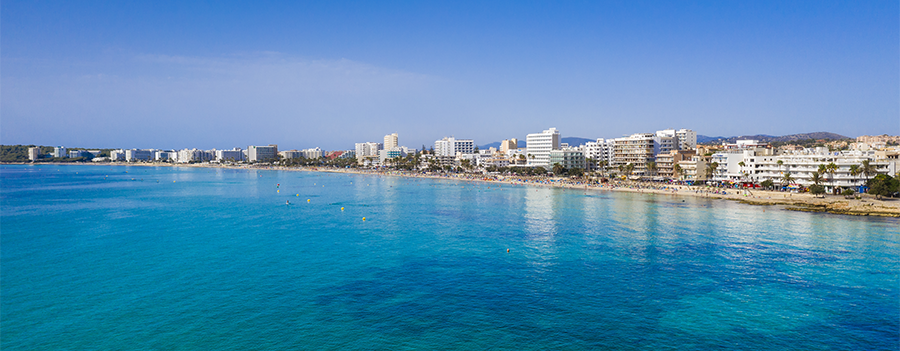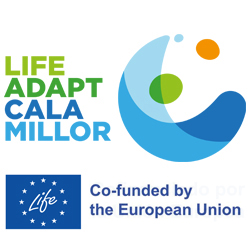
Long-term climate change adaptation project in the urban beach of Cala Millor by applying a collection of science-based guidelines through governance and participatory processes
See the project page at lifeadadaptcalamillor.com
From previous studies and the extent of the impact of sea level rise expected for 2050 and 2100 on the sandy coasts of the Balearic Islands, the Autonomous Government has proposed to adopt a strategic line of research to ensure the feasibility of natural adaptation solutions at cost, medium and long term
In the short term: socio-economic sectors demand sand nutrients, a high-cost and short-lived solution, adversely affected by the expected rise in sea level by the middle of this century.
In the medium term (30 years), consider a recovery of dune areas, even on urban beaches. It means changing the traditional image of how the coastal urban landscape should be, eliminating large promenades and concrete gardens for solutions closer to nature. This is possible if there is space to move back with the promenade.
In the long term (between 60-100 years), and with a climate change scenario, consider freeing up beach space by removing buildings.
Beaches are important coastal defenses but their retreat and disappearance increase vulnerability to hazards. The effects of climate change on beaches are related to changes in wave patterns and sea level rise. This will particularly affect urban beaches and their ability to adapt is limited by lack of space. The impacts of climate change are of particular concern in the Mediterranean region, where urbanization of coastal areas is significant. The Balearic Islands are particularly vulnerable to climate change and a significant loss of recreational value and GDP is predicted.
Between 2018 and 2021, the SOCIB Consortium, IMEDEA and UIB participated in the “Costes pel canvi” project to assess the effects of climate change on the coastal zones of the Balearic Islands and help plan adaptation measures. Sea level rise is expected to affect 833 hectares permanently and 204 hectares temporarily in 2050, and 3,465 hectares permanently and 427 hectares temporarily in 2100. IHCantabria, SOCIB and MedCities have also worked on the Strategy for Coastal Protection in the Balearic Islands to protect the coastline from climate change and improve cooperation between public administrations.
To ensure the long-term viability of natural adaptation solutions, it is necessary to adopt a strategic line of research. Artificial sediment delivery solutions are inefficient and unfeasible from an economic and environmental point of view. In the medium term, a recovery of dune systems could be considered. The LIFE program is the only source of EU funding dedicated exclusively to the environment and climate change, and has financed more than 900 projects in Spain since 1992. The LIFE AdaptCalaMillor project has been selected for a grant, with a total budget of 2,294,047 euros, of which 1,376,424 euros will be financed by the LIFE program. The project has been chosen for its credibility and expected impact, as well as for its sustainability and potential for replication in other sectors or locations.
The Government of the Balearic Islands will also contribute 419,694 euros to the development of the project. Cala Millor is a coastal resort of the Balearic Islands that multiplies in population during the summer, and is an example of a transformed ecosystem in which the lack of information when acting caused the alteration of the natural dune system of the beach. This resulted in the reduction of the dry beach and a risk to tourist resources. In 2004, a scientific report examined possible actions to mitigate erosion problems related to the natural dynamics of the beach. In 2010, a landscape management policy identified the land transformation operations needed to achieve an improvement of the overall landscape conditions. The LIFE AdaptCalaMillor project joins efforts for the drafting of the project to take a step forward in urban beach nourishment solutions, with the ultimate goal of transforming the urban environment of Cala Millor to achieve long-term resilience to climate change through the development of science-based, integrated, sustainable and stakeholder-focused guidelines.
The main objective of the LIFE AdaptCalaMillor project is to build a long-term climate change adaptation project in the urban beach of Cala Millor, applying a set of integrated, science-based guidelines and incorporating them into a consensus blueprint through governance and participatory processes. To this end, the project will involve all relevant stakeholders from the early stages of the project to investigate the most appropriate solutions to define the adaptation solutions to be implemented in Cala Millor, which will provide an opportunity to improve the coastal areas of the Balearic Islands. The project will use a multidisciplinary methodology, a multi-governance scheme and a process to move from adaptation proposals to ready-to-implement adaptation projects for replication in regional, national and European urban beaches. Specific project objectives include implementing a high quality project, learning an active process for engaging society and stakeholders, identifying the scope and implications of global change, developing a catalog of possible adaptation strategies, and selecting and designing adaptation strategies with nature-based and science-based solutions
The LIFE AdaptCalaMillor consortium consists of 10 partners, including regional and local authorities, business associations, research institutes and environmental foundations. The project is coordinated by the “Consejería Empresa, Empleo y Energía. Dirección General Economía Circular, Transición Energética y Cambio Climático”. In addition to the municipalities of Son Servera and Sant Llorenç des Cardassar, the Tourism Consortium of Cala Millor Bay and the business and hotel associations of Cala Millor and sa Coma, five research partners are also participating: SOCIB, UIB, CSIC-IMEDEA, IHCantabria, LANDLAB and the CONAMA Foundation.

